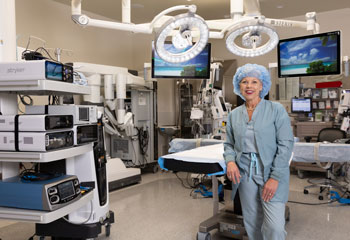Video-Assisted Thoracic Surgery Lobectomy
Video-assisted lobectomy is a minimally invasive lung cancer surgery and the gold standard for removing tumors limited to one lobe of the lung.
When detected in its earliest stages, lung cancer can often be effectively treated through surgical resection of the tumor and surrounding lymph nodes in the chest. While conventional lobectomy involves a large incision in the chest (thoracotomy) and cracking of the ribs to access the lungs, VATS lobectomy is performed through several small incisions with high-tech instruments and minimal tissue damage.
VATS lobectomy advantages
Compared with a standard lobectomy, the advantages of VATS lobectomy include:
- Reduced post-operative pain
- Shorter hospital stay
- Lower risk of complications
- Improved post-operative pulmonary function
- Faster overall recovery
Unfortunately, to this day many thoracic surgeons are not fully trained in VATS lobectomy for early stage lung cancer treatment. At UCI Health, we use the VATS technique. Our doctors have trained extensively in the use of VATS and are highly regarded as leaders in the field of minimally invasive thoracic surgery.
Eligibility for VATS lobectomy
When selecting an appropriate surgical resection procedure, it is critical to balance the need to resect as much of the tumor as possible with the goal to preserve as much healthy lung tissue as possible.
Our doctors will carefully assess the stage and characteristics of your tumor as well as your general health to determine if VATS Lobectomy is right for you.
Candidacy for a VATS lobectomy is determined by the following criteria:
- Cancer stage (Predominantly used for stage 1 lung cancer)
- Tumor Size (< 6 cm)
- Performance on a pulmonary function test
Contraindications for VATS lobectomy include large tumors (>6 cm) and chest wall or mediastinal invasion.
The effectiveness of VATS lobectomy for the resection of stage 2 lung cancer is a topic of debate. Clinical studies are currently underway to compare the treatment outcomes after VATS lobectomy with those after a conventional “open” technique.
Video-assisted lobectomy procedure
VATS Lobectomy is performed entirely through four small (~5 mm) incisions in the chest underneath the arm.
While under general anesthesia, a thin fiber-optic camera is inserted into the chest, providing our surgeons with high-definition video feed from within the chest cavity throughout the entire procedure.
Using video assistance, our surgeons meticulously locate and dissect the lobe of the lung with the tumor, as well as nearby lymph nodes and blood vessels that are supporting the tumor. The isolated lobe is then cut free from the lung, placed in a sterile bag, and removed from the body through a guide tube.
Once the lobe and tumor have been resected, all instruments are removed from the body and the incisions are closed with sutures.
VATS Lobectomy should only be performed by a highly experienced thoracic surgeon with expertise in the video-assisted thoracic surgical technique. The procedure requires excellent video skills and knowledge of thoracic anatomy.
What to expect after surgery
Recovery time following VATS lobectomy varies from person to person. Most patients spend one to three days in the hospital, followed by up to a week of recovery at home before returning to daily activities. Routine follow-up appointments are critical after surgery to help ensure tumor remission.
After lung cancer surgery, some patients are recommended to undergo chemotherapy and/or radiation to help prevent the recurrence of cancer. The need for these adjuvant therapies is determined by the results of surgery and the specific tumor characteristics.
To make an appointment with a thoracic surgeon, call 714-456-8000.








